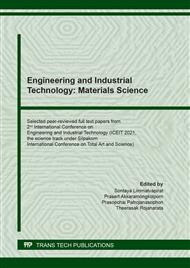p.3
p.9
p.15
p.23
p.31
p.37
p.45
p.53
Impact of Polymers as Precipitation Inhibitors on Physicochemical Properties of Spray-Dried Astaxanthin-Loaded Self-Microemulsifying Delivery Systems
Abstract:
Supersaturated astaxanthin (AST)-loaded self-microemulsifying delivery system (SMEDS) was developed and formulated with polymeric precipitation inhibitors (PPIs) to improve the dissolution profile of AST. Based on our preliminary in vitro polymer screening test, hydroxypropyl cellulose (HPC-L) and polyvinyl alcohol (PVA8/88) were selected as PPIs and studied further in this work. Microemulsions prepared from AST SMEDS (composed of AST, rice bran oil, Kolliphor® RH40, and Span® 20) were mixed with maltodextrin (MD) as a solid carrier and each PPI solution and then solidified using a spray drying technique. Particle size of spray-dried S-MD-HPC powder had larger circular equivalent (CE) diameter (14.69 ± 0.75 μm) than the other formula and showed particle agglomeration in SEM images. Spray-dried S-MD-PVA powder had 8.94 ± 0.37 μm CE diameter, and smooth surface of particles was observed. Amorphous phase transformation and chemical compatibility of both spray-dried powder formulations were detected by FT-IR, PXRD, and DSC. S-MD-HPC had marginally slower dissolution rate and release profile of AST compared to those of S-MD-PVA; however, both HPC and PVA polymers exhibited the ability for AST precipitation prevention and solubilization enhancement. Although AST degradation was caused by high temperature, physicochemical properties of the spray-dried AST SMEDS (S-MD-HPC and S-MD-PVA) powders after reconstitution were not significantly changed upon storage at 30°C/ RH 75%. This study illustrated a novel platform of spray-dried AST SMEDS in combination with HPC or PVA as a polymeric precipitation inhibitor for improvement of AST loading, solubility, and stability.
Info:
Periodical:
Pages:
15-21
Citation:
Online since:
March 2022
Authors:
Price:
Сopyright:
© 2022 Trans Tech Publications Ltd. All Rights Reserved
Share:
Citation:


